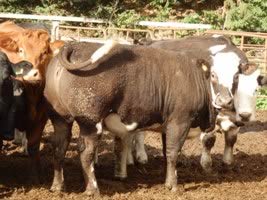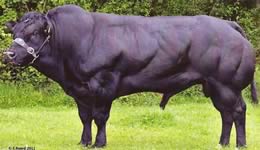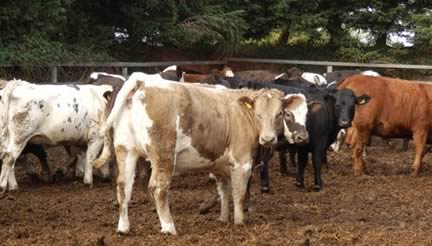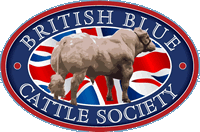Good Quality Bulls Equals Good Quality Calves
"The day you stop learning is the day you die!" This is the philosophy employed by Keith Barrow of R & F Barrow & Son, Halsey Cross Farm, Over Stowey just outside Bridgwater in Somerset. Keith, together with his father Ray and two sons James (20) and George (18) run a 210 cow suckler unit near the picturesque marshes around Bridgewater. The farm runs to 600 acres of grass which would normally be ample for a unit of this size but with almost drought conditions in the last two summers, the management of the farm and its animals has become increasingly more important.
Prior to the 1996 BSE crisis, the mainstay of the family business was the export of around 500 calves a week into Europe, while the farm itself was run by two farm workers, both of whom left shortly after the ban was introduced, leaving the family to make some major decisions on how they were going to continue. Keith and his father Ray had to take a good look at the farming side of the business, which he admits at that time was just running alongside the more lucrative export business with little input from the family into the running or management of the herd. Overnight, the situation changed and the farm became the only viable part of the business as the export ban on calves was introduced. Keith was forced to take a good look at the herd and how it was going to produce a sustainable business for the family to continue. “It was a sharp learning curve which is still going today.” admits Keith. “We had all been too busy with the export business to really pay attention to the suckler herd and the exports had been subsidising the farm for a long time. I had to decide to change the system to make it pay and this meant I had a great deal to learn over the coming years, much of it trial and error!” he smiles.

A plan of action was developed over the next 10 years, which has varied in direction on occasion but has stuck to the primary aim of trying to increase the profit of the herd. The plan involved improving the stock, improving the management of the stock and developing a farming system which would enable three generations to work together and have an input into the family unit.
The first thing the family did was to look at the cows they ran and decide to customise the herd into a more consistent type of cow. Until this point, no particular attention had been paid to the breeding or feeding side of keeping the cattle. The heifers were bulled with the Limousin bull and the second calvers with the Simmental and kept as replacements. However, following a trip to Chelford and a look at the potential of the British Blue, Keith bough is first two bulls from the for £1500 each. “At that stage, I just bought to a price, which I still do but I began to learn that the better the bull, the better the calves.” says Keith.
The cows had to work harder and have a better cost of production ratio than they had before so the breeding programme developed by continuing to use the Simmental cross as a good base for the Blue. Keith liked the Simmental and the placid nature of the Blue cross Simmental, which was easier to work with than the Limousin, although he still prefers the Limousin for the heifers. After their second calf, everything which calved down OK to the Simmental was put to the Blue for the rest of her productive life.
Cows were not kept in production as long as they had been in the past, as the depreciation of the cow had changed significantly since they were allowed back into the food chain and it made sense to use them at their best and get them away after around 5 calves, when they still came to a good amount of money. Breeding their own replacements allowed the family to maintain the quality of the herd and maintain a better health status. An infertility issue with the heifers was looked at and the soil tested which showed a major lack of Copper which was dealt with as was a scouring problem in calves, caused by Coronavirus. Minerals were introduced and the conception of the herd increased dramatically by some 15% -20%. Better quality British Blue bulls were bought and the herd moved to all spring calving.
“I like to support Chelford Mart if I can” says Keith “but I took a trip to Carlisle Blue Sale and had a good look at what was on offer there. Blue genetics were what I needed! I wanted good quality calves and had discovered that came with good quality bulls and I also wanted continuity of colour for the store market and a placid breed to work with. By using the British Blue as my primary Bull, alongside the Simmental and Limousin, I had the best of all three breeds.”

Greystone Carbon
Purchased Chelford 2009 for 8,200gns
Calving periods have been tightened up over the past few years and by next year the bulls will be removed by the second week in August for a February start to calving which will last around seven weeks.
Following a TB breakdown, which is now clear but with and the never ending threat of the disease in the area, all of the calves are now taken through to finish to prevent frequent tests affecting the herd.
The introduction of a Keenan feeder and their work with the Keenan nutritionist David Hendy, has paid huge dividends on the ability of the herd to thrive and maintain condition at particular times of the year and the finished cattle can now be targeted towards the peak times in the market rather than risking some being finished at the annual troughs in the finished market.
“The Blue steers and heifers finish well on the ration from the feeder, which is monitored by the Keenan PACE computer system and regulates the daily intake for each particular batch of cattle alternating it automatically when cattle are either introduced or removed for market.” Keith explains. “It costs me £5 a day to rent the system but it pays for itself easily in making sure that the right quantities of feeding are being given and there is less waste. We hadn’t been using the wrong feed elements in the past but adjusting the ratios has paid major dividends.”
The quality carcass of the Blue cross finishers allows the farm to produce around 40 suckled “E” type calves for Chellford in the spring, which helps with the cash flow for that time of year with the rest being finished as mostly U’s. “Those which are R’s are normally traced back to some of my older more traditional breeding from years ago.” laughs Keith.
“Working on 4 different TMR rations helps us to manage the cows better and target their growth and production periods, which also means we can leave them out on the Marshes till November, bring them home to calf and put them out again mid April, saving on straw which is costly in this area.”

Cattle are free to move in and out
This year has seen the introduction of 100 acres of Winter Wheat as a new venture to help improve the crop rotation and reseeding has been done on poorer quality fields which are rented and are now beginning to show the benefits in the cattle.
From a standing start, the Barrow family have made use of all of the information available to them to develop their herd to produce a good end product with a targeted market to gain the most out of their cows. “The British Blue has helped us achieve our aims to date.” says Keith. “It’s producing good quality calves which are consistent and docile as replacements which is what we want for a family farm. The farm isn’t big enough to support all of us and the boys work for neighbours as well to help with the income but our cows are allowing us to continue to have a family business which is the most important thing for us. There have been times when I’ve been speaking to nutritionalists or agents of pedigree breeders when I was sure they must have thought I was just thick!” laughs Keith “I’ve learned so much in the past 10 years about good breeding and good feeding and I know that’s the way forward.”

